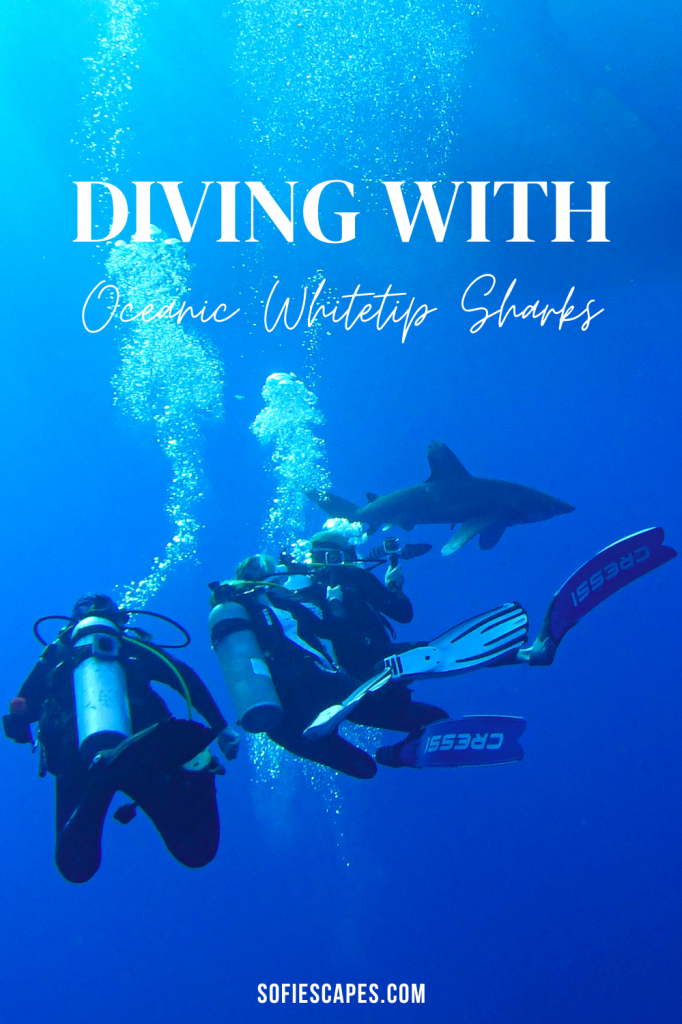Diving into the azure depths of the Red Sea, I found myself in a thrilling encounter with the oceanic whitetip sharks. Contrary to the conventional wisdom that such close encounters are rare, my journey through Brothers Islands and Daedalus Reef was a saga of continuous rendezvous with these amazing sharks.
Diving with sharks is an extraordinary adventure, and for many divers, encountering Oceanic Whitetips in the Red Sea offers a unique experience. In this blog post, we'll delve into the facts surrounding these remarkable sharks, explore personal encounters, and provide insights into specific locations in the Red Sea where your chances of encountering them are high.
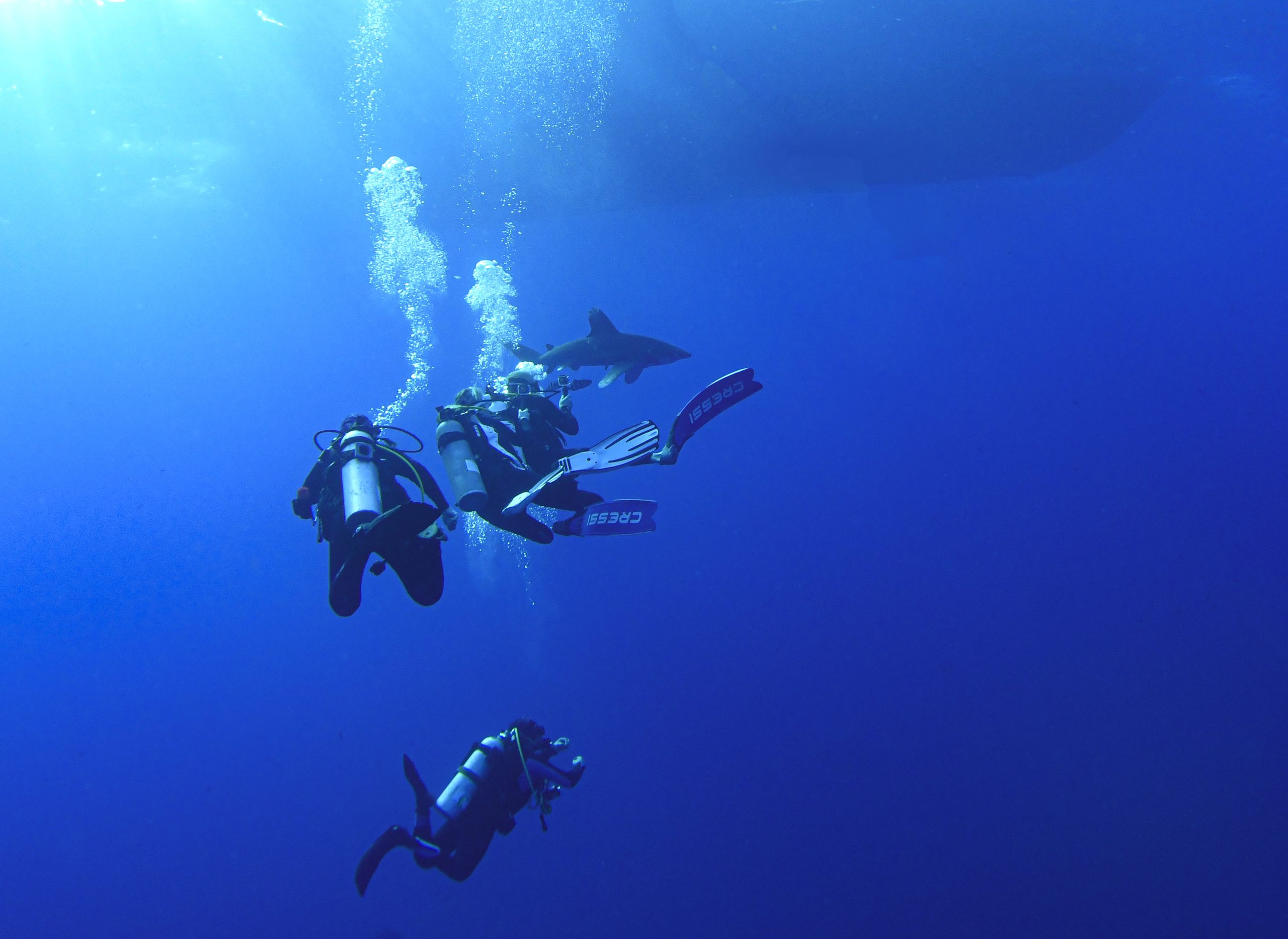
Close Encounters with Oceanic Whitetip Sharks in Egypt
As we gathered for our first dive at the Brothers Islands, a shroud of anticipation enveloped us. A dive briefing unfolded, a mix of caution and excitement. Do's and don'ts echoed, accompanied by jaw-dropping videos illustrating the majesty and potential dangers of the oceanic whitetips. An uneasy thrill gripped the group; after all, sharks are elusive big pelagic predators of the high seas, or so we were told.
Contrary to expectations, the Brothers Islands greeted us with an immediate introduction to the oceanic whitetip. Dive after dive, the majestic creatures graced us with their presence. Jokes arose about a personal entourage, as the sharks seemed to follow me persistently, whether I entered from a boat or a zodiac. It was a dance of shadows beneath the waves. Amidst the routine encounters, a super encounter awaited. On our way back to the boat at a mere 5 meters depth, the oceanic whitetip made a grand entrance. A circle formed around me and my father as the shark gracefully parted us, centimeters from our existence. In the underwater theater, it separated divers, curiously investigating cameras and creating an unforgettable spectacle.
The close super encounter unfolded, a heart-stopping two minutes that felt like an eternity. Adrenaline surged as the shark's proximity became palpable. With laser focus, I held still, wary of the potential dangers. It passed by a second time with breathtaking proximity, revealing intricate details of its skin. The oceanic whitetip's departure left lingering emotions, legs shaking, and an indescribable thrill.
As the shark gracefully veered away, our group descended to 10-15 meters for safety. Time seemed suspended in the deep blue. Realizing the shark's absence, we ascended for a second safety stop before emerging, two by two, from the underwater spectacle. It was an adventure etched in adrenaline, eternally etched in my memory.
Back on the boat, adrenaline coursed through my veins. The decision to skip the third dive was made, opting for a glass of wine to soothe the senses. Amidst relaxation, the encounter's vivid imprint lingered into the night and the following morning. The rarity of the moment resonated – a testament to the marvels of the deep and the incredible luck bestowed upon us.
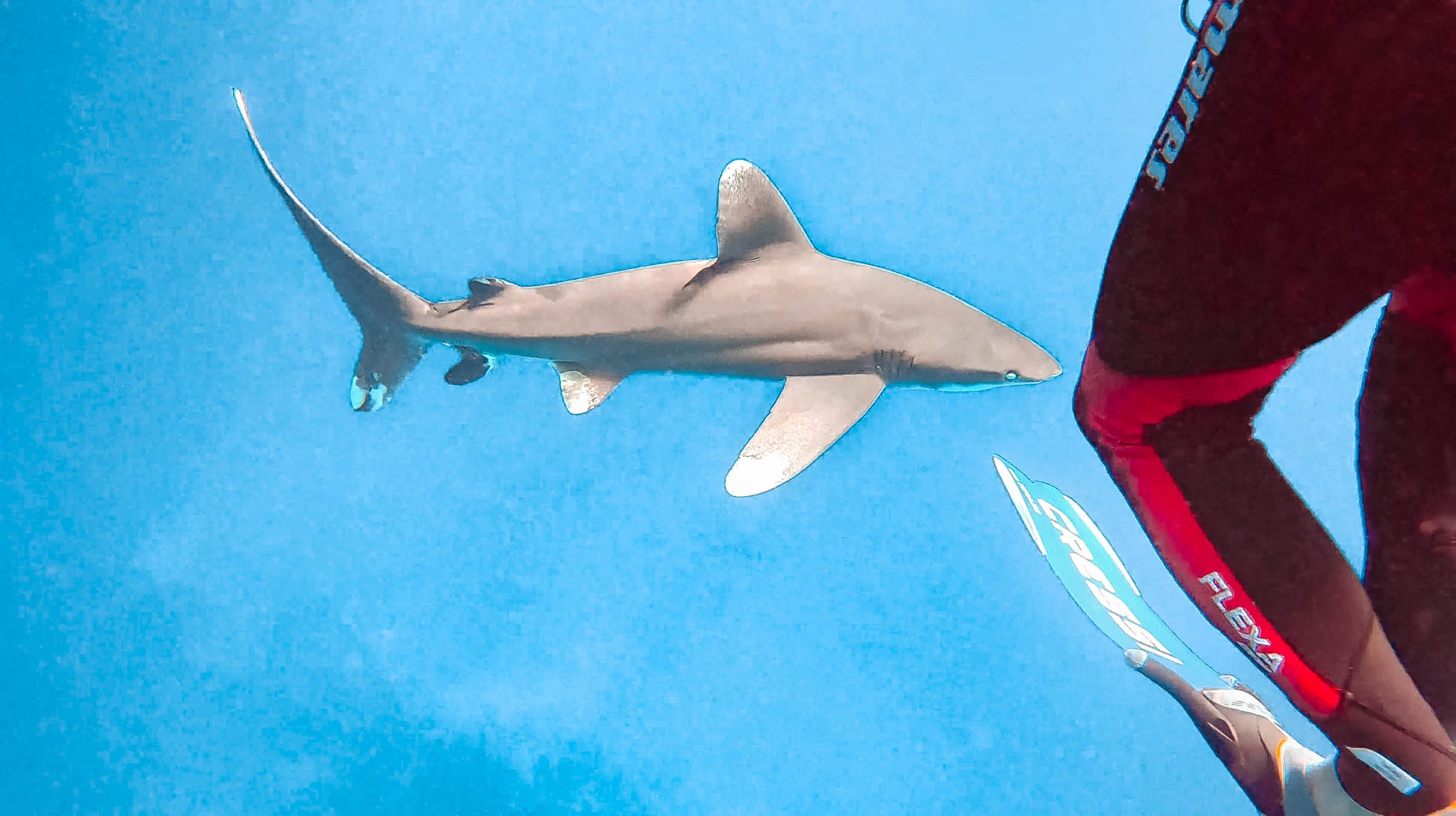
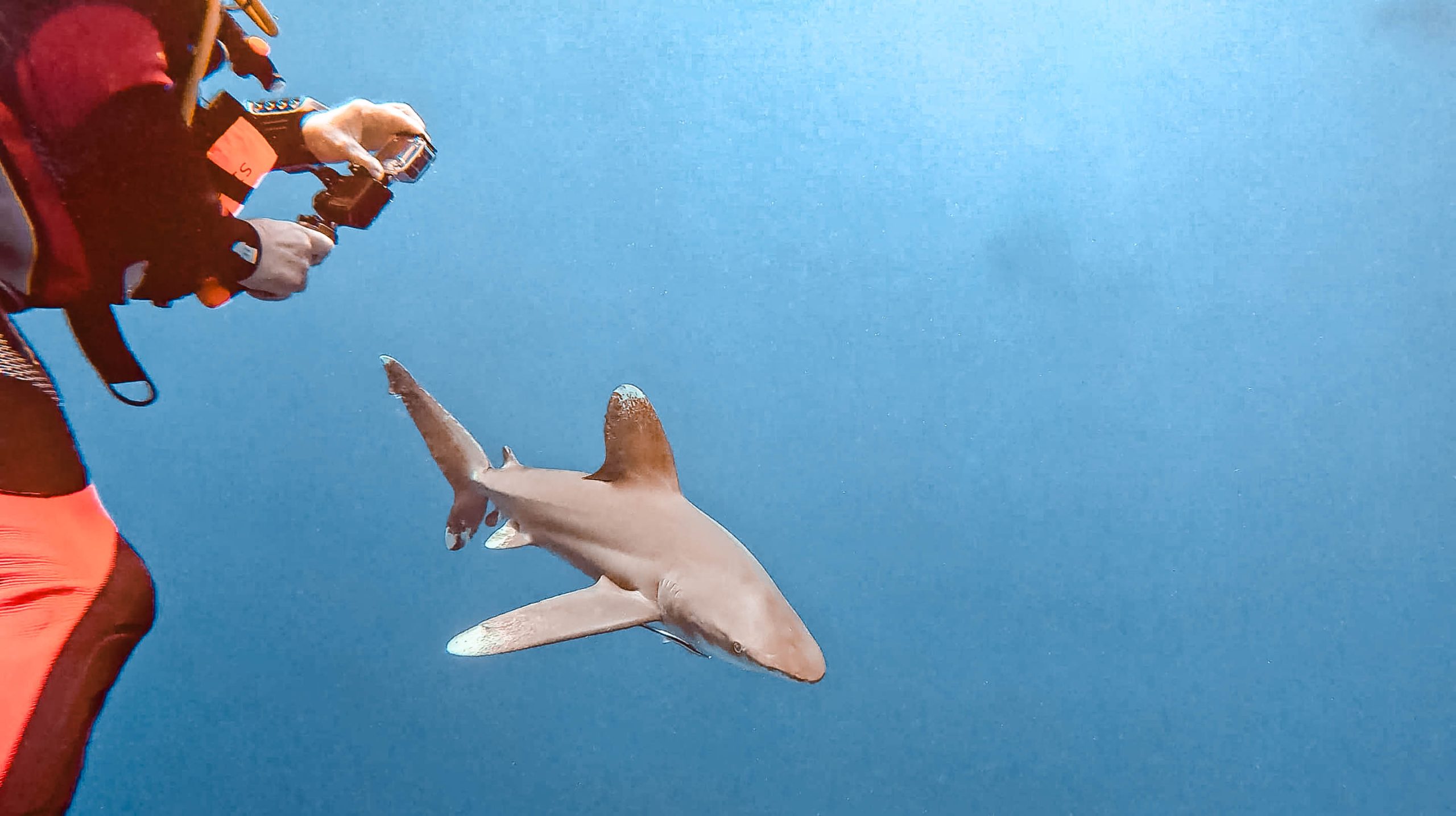
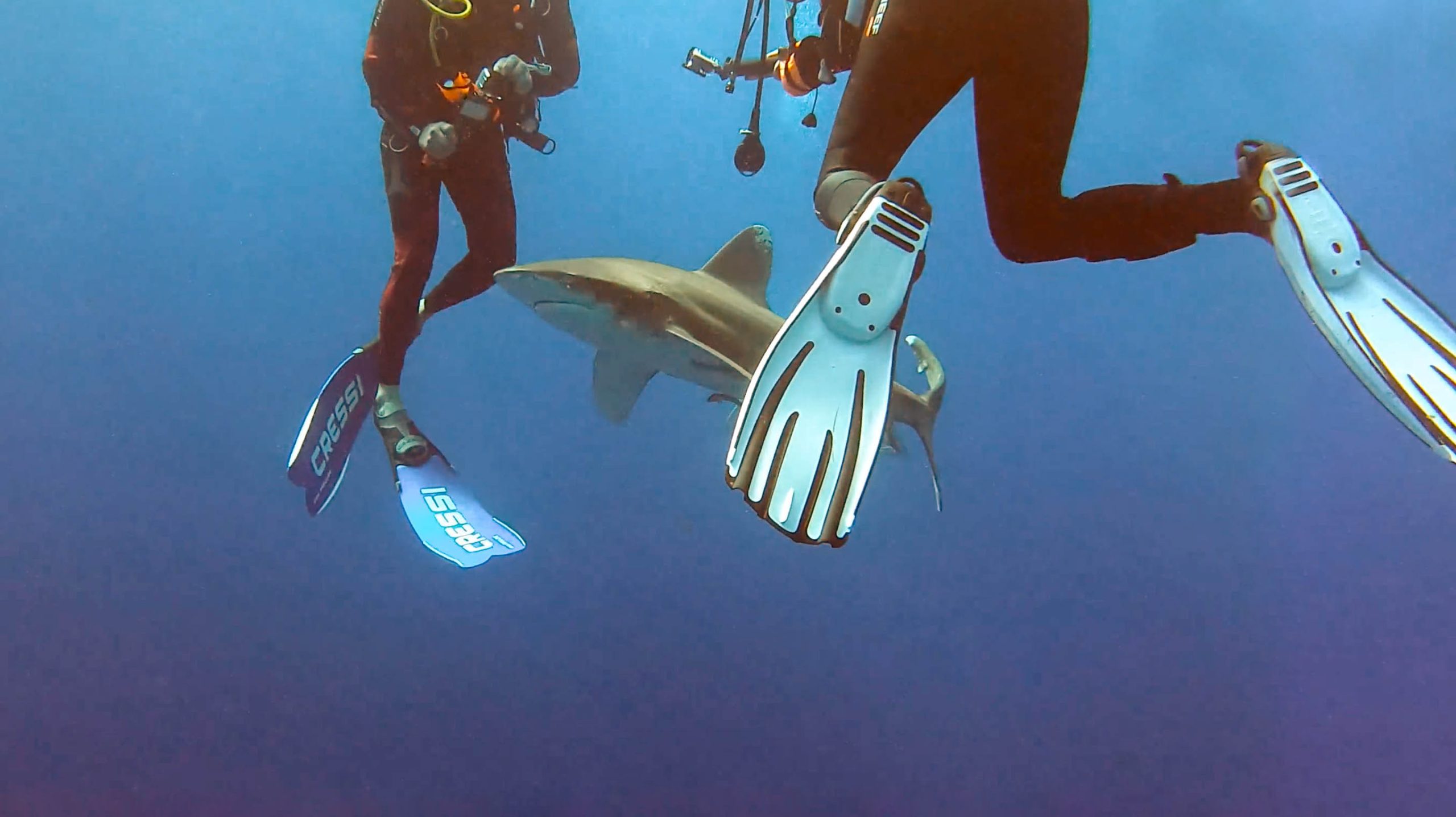
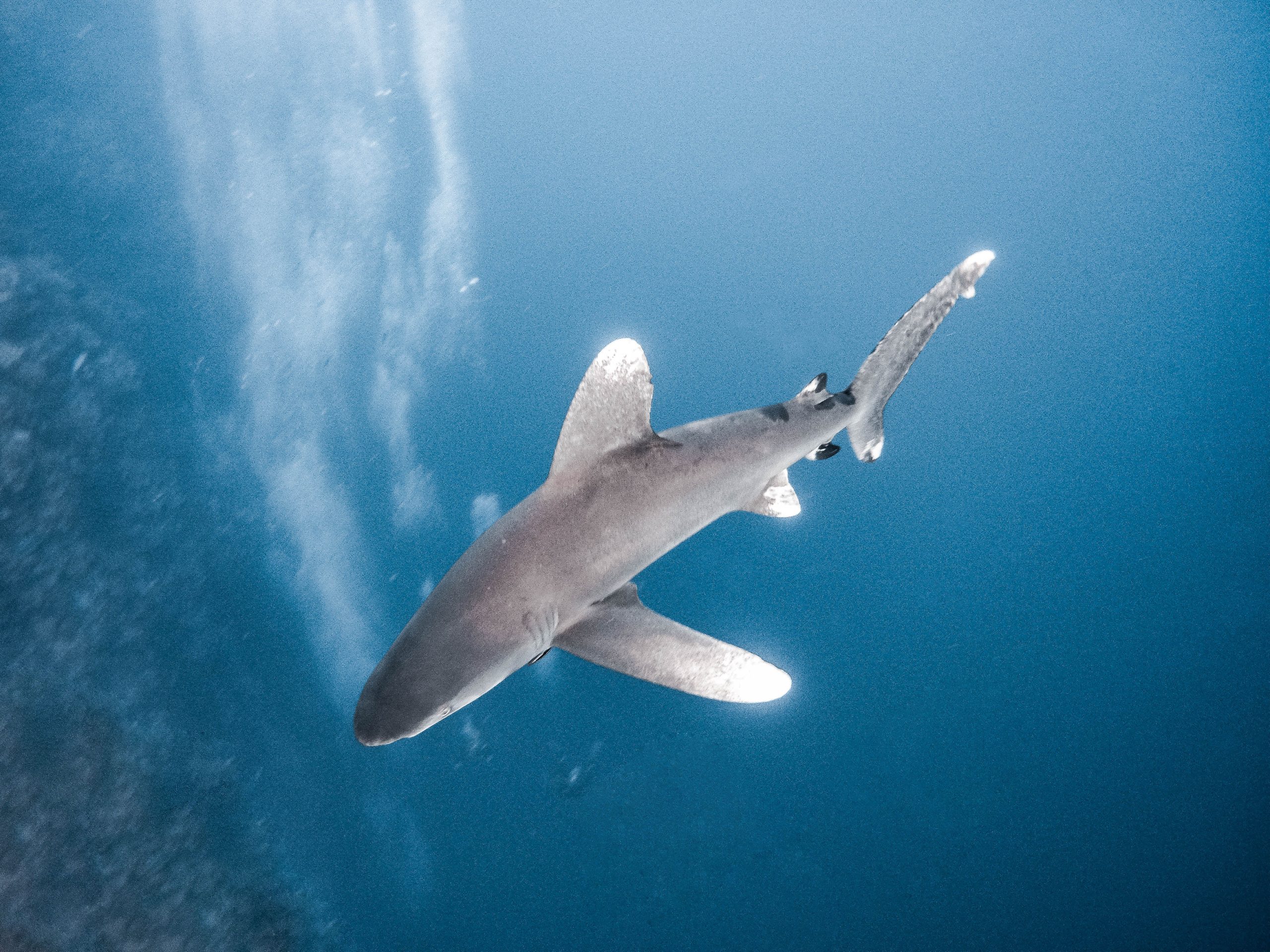
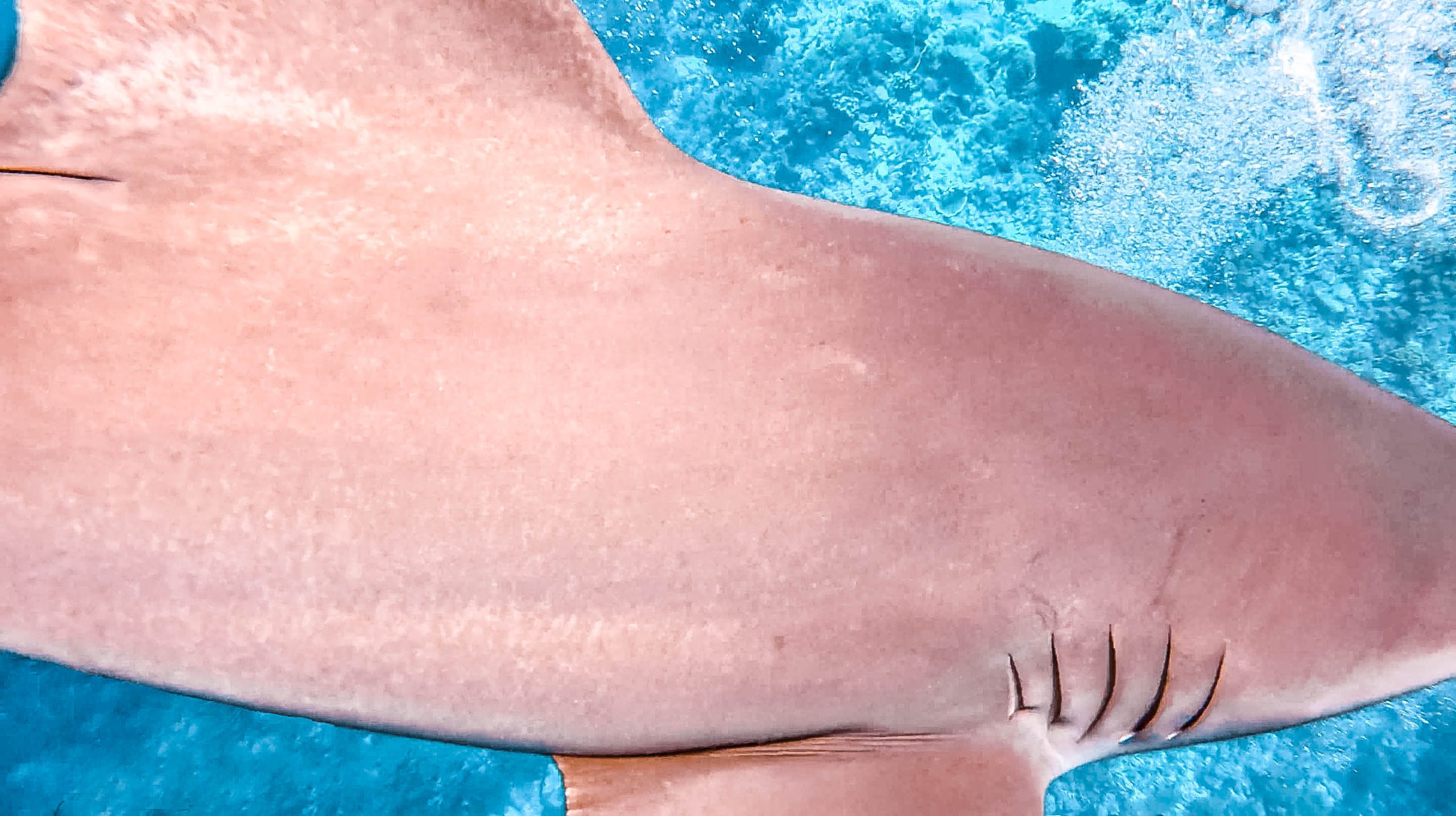
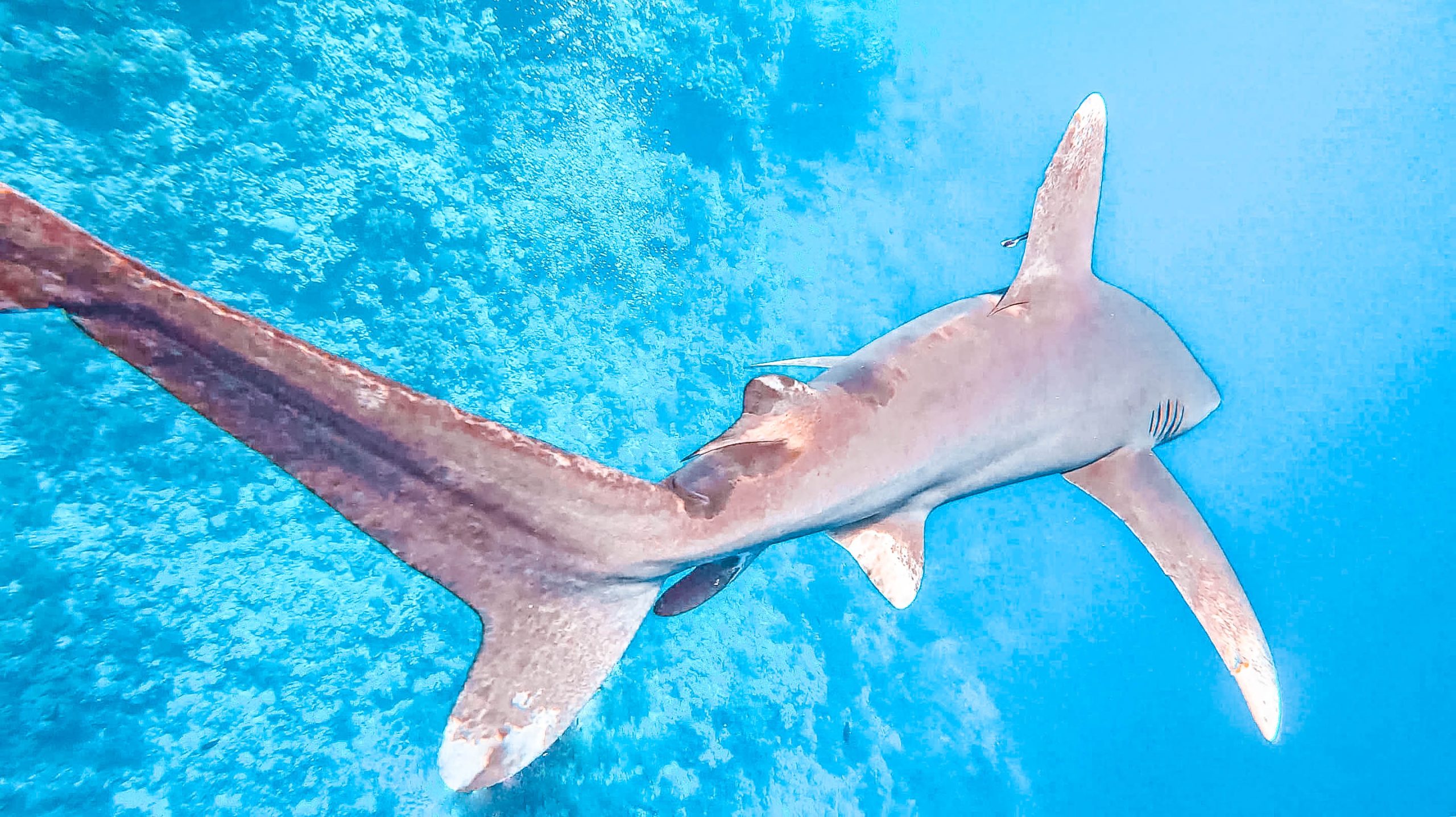
Facts About the Oceanic Whitetip Shark
Carcharhinus Longimanus, the Oceanic Whitetip, is a pelagic shark that roams the open ocean, driven by an endless quest for food. Recognizable by its distinctive large pectoral fins, translating from Latin as 'long hands,' Oceanic Whitetips can reach lengths of approximately three meters and weigh up to 170kg. Unlike many other shark species, Oceanics exhibit an unnervingly confident demeanor, often approaching divers with curiosity.
These sharks have adapted to a life of constant movement, relying on their unique fins to glide effortlessly through the water. Their rounded dorsal and pectoral fins act like sails, reducing energy consumption during long-distance travel. Oceanics are slow-moving, solitary predators that cruise just below the water's surface, scanning for prey. As the sun sets, their predatory instincts intensify, making encounters during late afternoons particularly memorable.
Accompanying these oceanic behemoths is the elegant pilot fish (Naucrates ductor), forming a symbiotic relationship. The fish cleans parasites from the shark, while the shark provides protection. This underwater partnership is often referred to as "Jewellery" in diver jargon.
It's essential to approach Oceanic Whitetips with respect, understanding that their curiosity stems from a relentless pursuit of food in the vast open ocean. Despite their potential danger, they are highly intelligent and not recklessly aggressive. Divers should be mindful of safety guidelines, especially considering their investigatory bites when encountering unfamiliar objects.
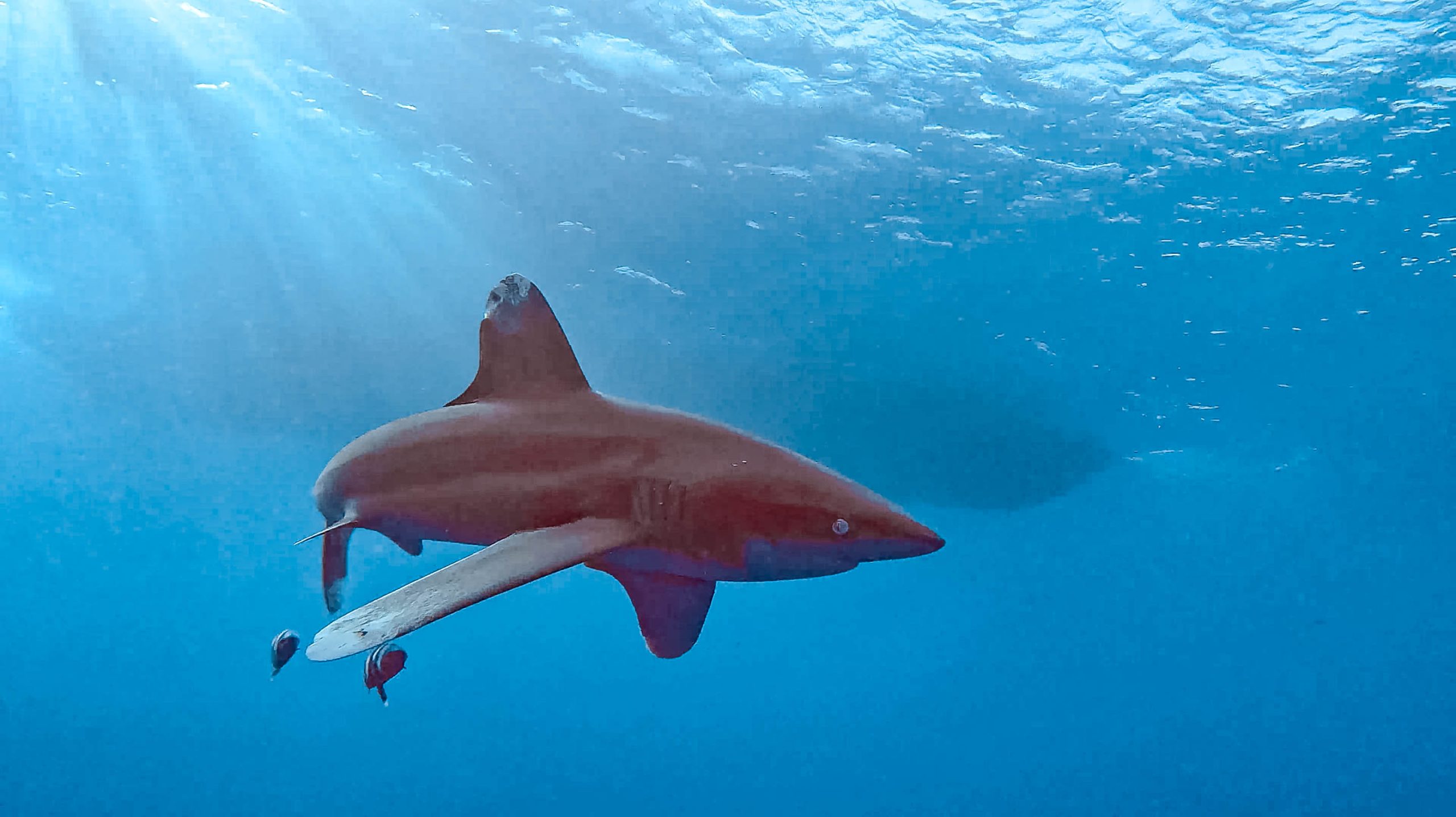
Scuba Diving Brothers Islands With Oceanic Whitetips
Most of my encounters with Oceanic Whitetips unfolded in the southern part of the Egyptian Red Sea, particularly around the Brothers Islands. These two small offshore islands, named "Big Brother" and "Little Brother," are situated approximately 60-70km from the coast at Al Qusair. Designated as natural protectorates in 1983, these islands boast marine park status, ensuring a thriving coral reef ecosystem and the presence of pelagic sharks, including the curious Oceanic Whitetips.
Diving at the Brothers Islands is a multifaceted experience. The underwater landscape includes the wrecks of "Aida" and "Numidia," vibrant coral reefs, dramatic walls, and the opportunity for drift dives. The remote location, accessible only by liveaboard, contributes to the islands' pristine conditions. As you explore the underwater wonders, don't be surprised if Oceanic Whitetips make an appearance, often patrolling between liveaboards.
However, diving at the Brothers Islands requires preparation. Advanced divers with a minimum of 50 dives are advised due to challenging conditions—strong currents, rough surface conditions, big pelagic fish at depths below 18 meters and a bustling atmosphere with numerous zodiacs. A negative entry and swift exits from the water are recommended, as Oceanic Whitetips are known to investigate activities on the surface, creating potential stress for inexperienced divers.
The ideal time for encounters is from September to early December. As you go on this adventure, remember that each dive is a unique opportunity to witness the grace and confidence of these fascinating sharks.
Read my full experience on our liveaboard expedition on Brothers Islands, Daedalus Reef, Sataya Reef and Fury Shoals here.
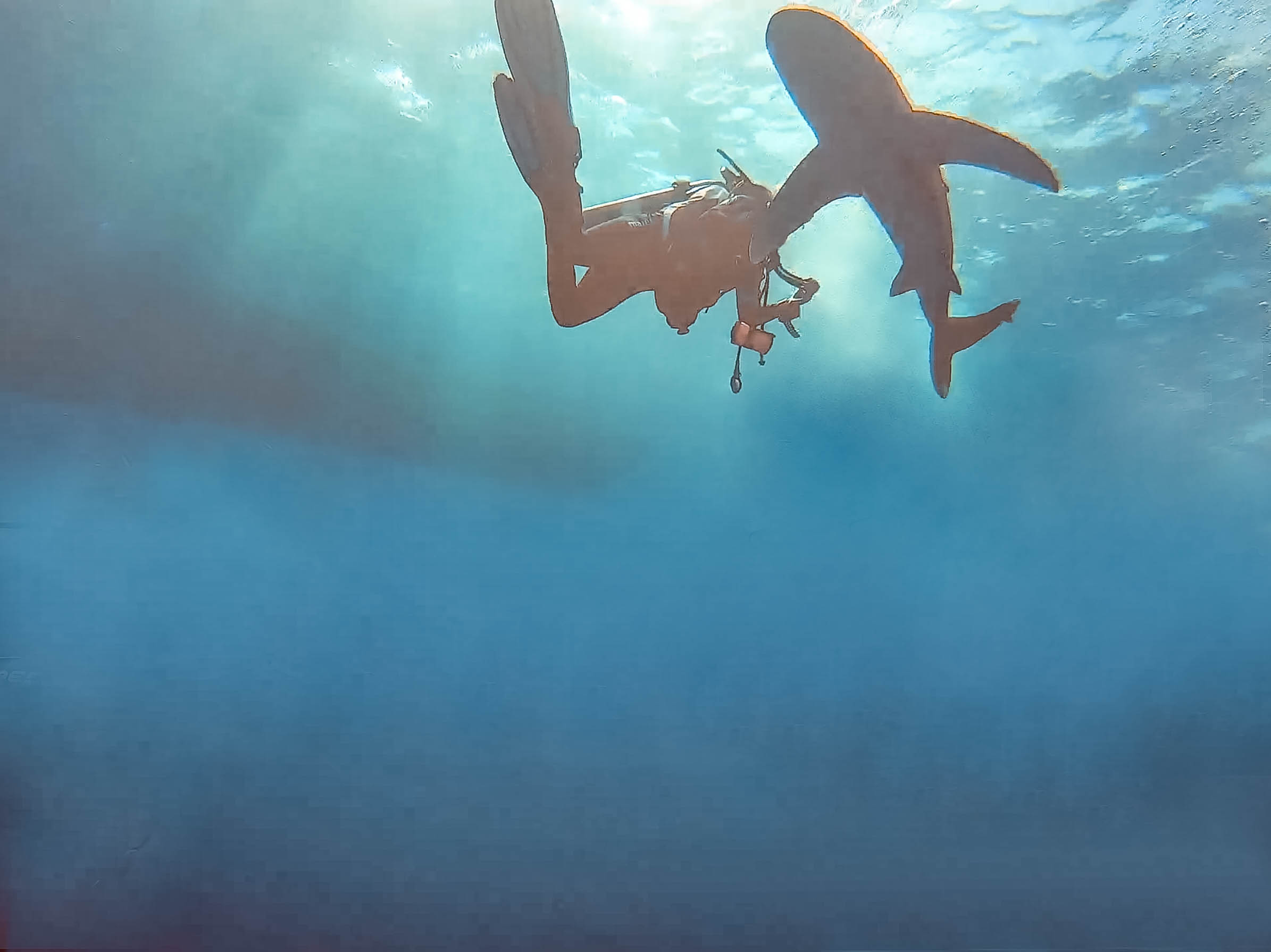
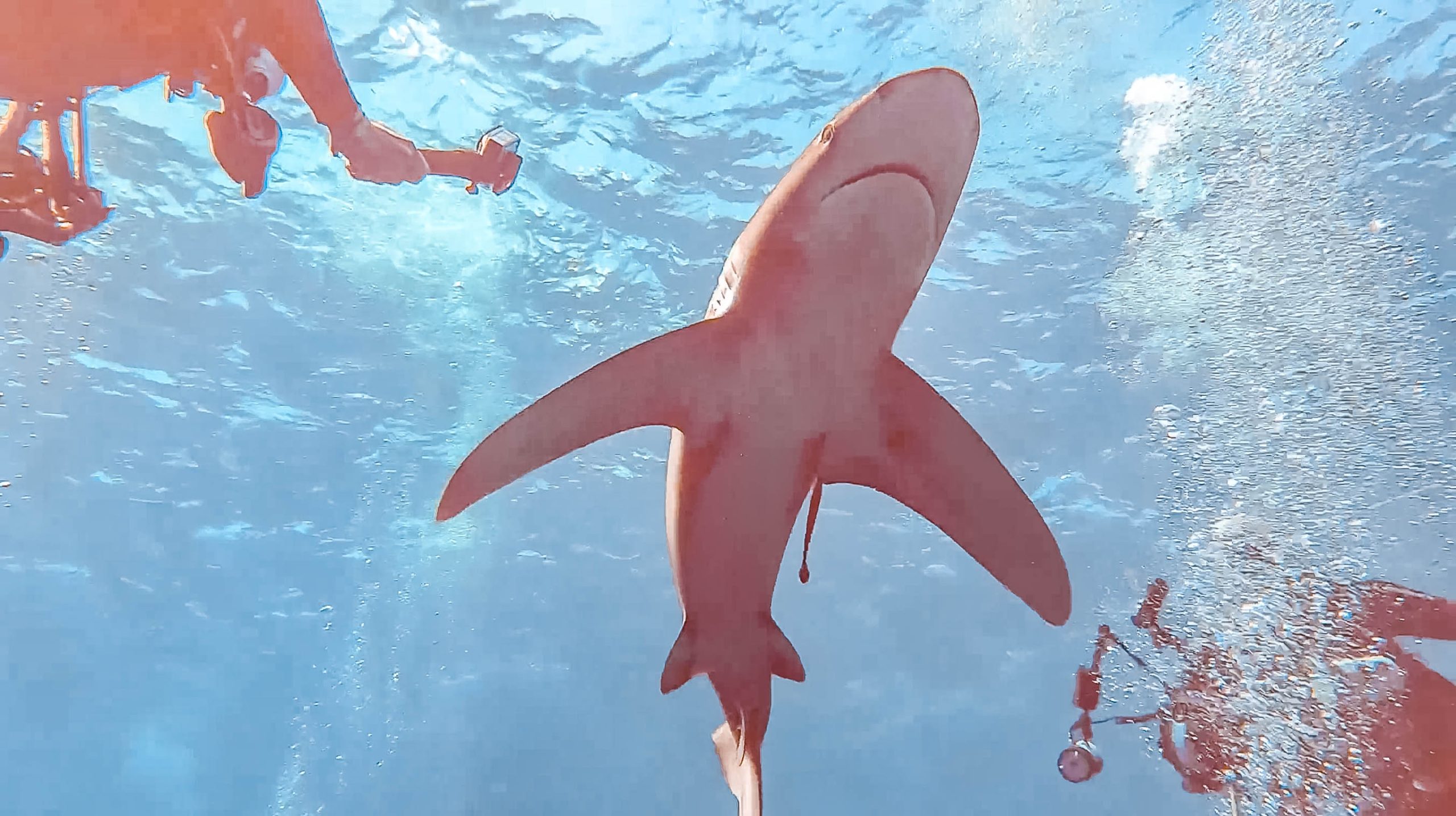
Oceanic Whitetip Sharks Numbers are Decreasing Fast
While diving with Oceanic Whitetips provides a mesmerizing experience, it's essential to recognize the grave threats pushing these creatures to the brink of extinction. Classified as Critically Endangered by the IUCN Red List, Oceanic Whitetips face relentless fishing, both intentional and incidental.
Added to CITES Appendix II in 2013, attempts were made to regulate the trade of these sharks. However, the situation worsened, with a recent downgrade to Critically Endangered in the Northwest and Western Central Atlantic. Caught globally in various fishing methods, their population has dwindled by over 98%, demanding urgent conservation attention.
Encounters with these sharks often reveal haunting scars, remnants of encounters with fishing gear. The rise in longline fishing, driven by the demand for shark fin soup, has been a significant contributor to their decline. An estimated 250,000 to 1.3 million Oceanic Whitetips are caught annually for the fin trade.
Witnessing these sharks in their natural habitat takes on a poignant tone, highlighting the urgency for global conservation efforts. The Oceanic Whitetip's decline serves as a stark reminder of the pressing need to protect these majestic creatures from the precipice of extinction.
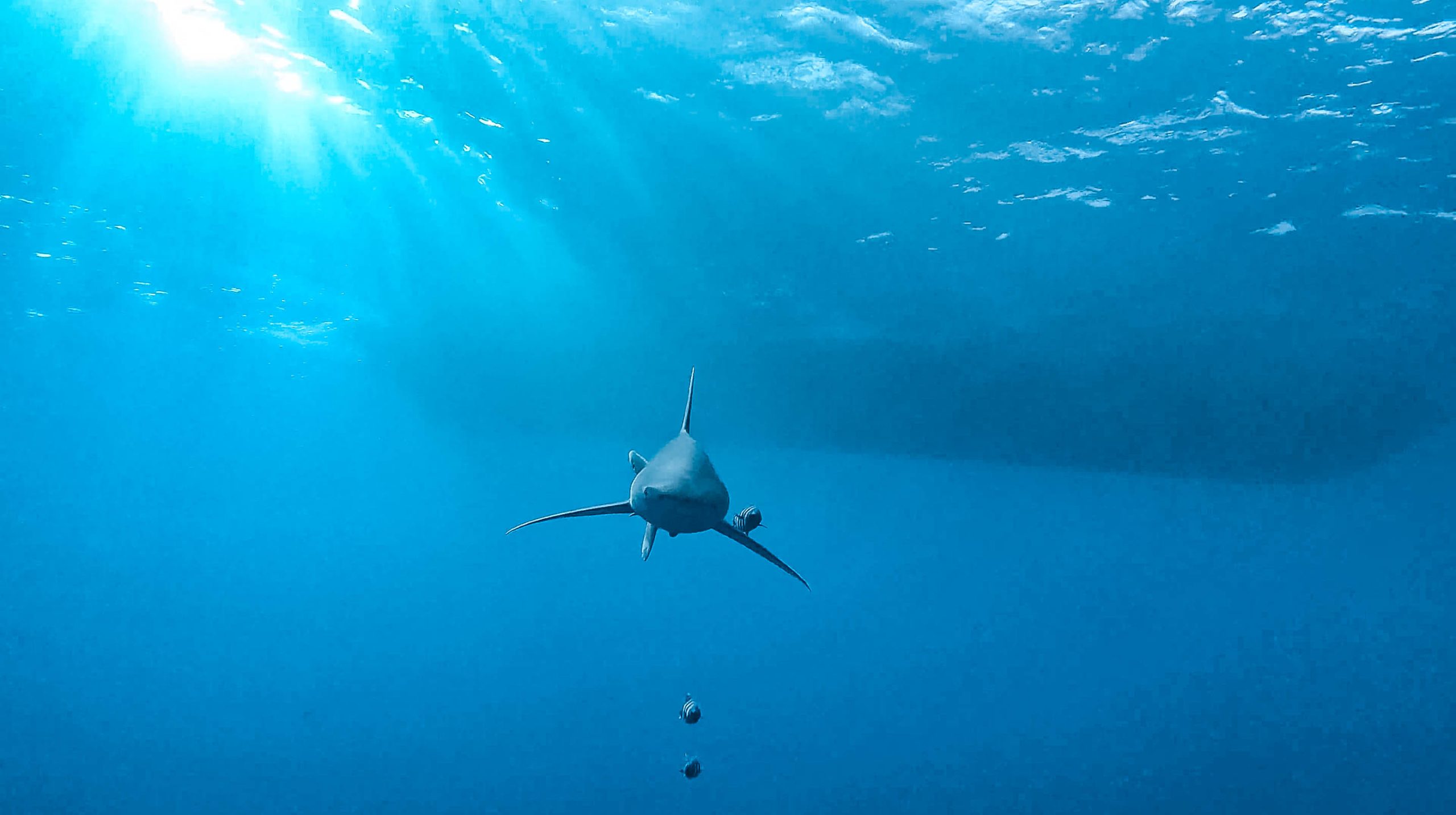

Shark Attacks in Egypt
In recent times, Egypt has witnessed an increase in shark attacks, prompting concerns and investigations. While the incidents have raised alarm, it's crucial to differentiate between the Oceanic Whitetip and the species implicated in these events, such as the Bull and Tiger Sharks.
The rise in shark attacks is multifaceted, often linked to human activities impacting the marine ecosystem. Overfishing and the depletion of natural prey can drive sharks closer to shores in search of alternative food sources, increasing the likelihood of encounters with humans.
Notably, the practice of shark feeding, though banned in Egypt, has persisted in certain areas. This unnatural interaction can alter shark behavior, associating humans with food and potentially leading to more aggressive encounters.
Understanding the nuances of these incidents is vital. While Oceanic Whitetips are not typically associated with attacks on humans, the broader context of shark-related incidents in Egypt emphasizes the importance of responsible and sustainable marine practices. Conservation efforts and stringent regulations are imperative to strike a balance between preserving these apex predators and ensuring human safety in Egypt's waters.
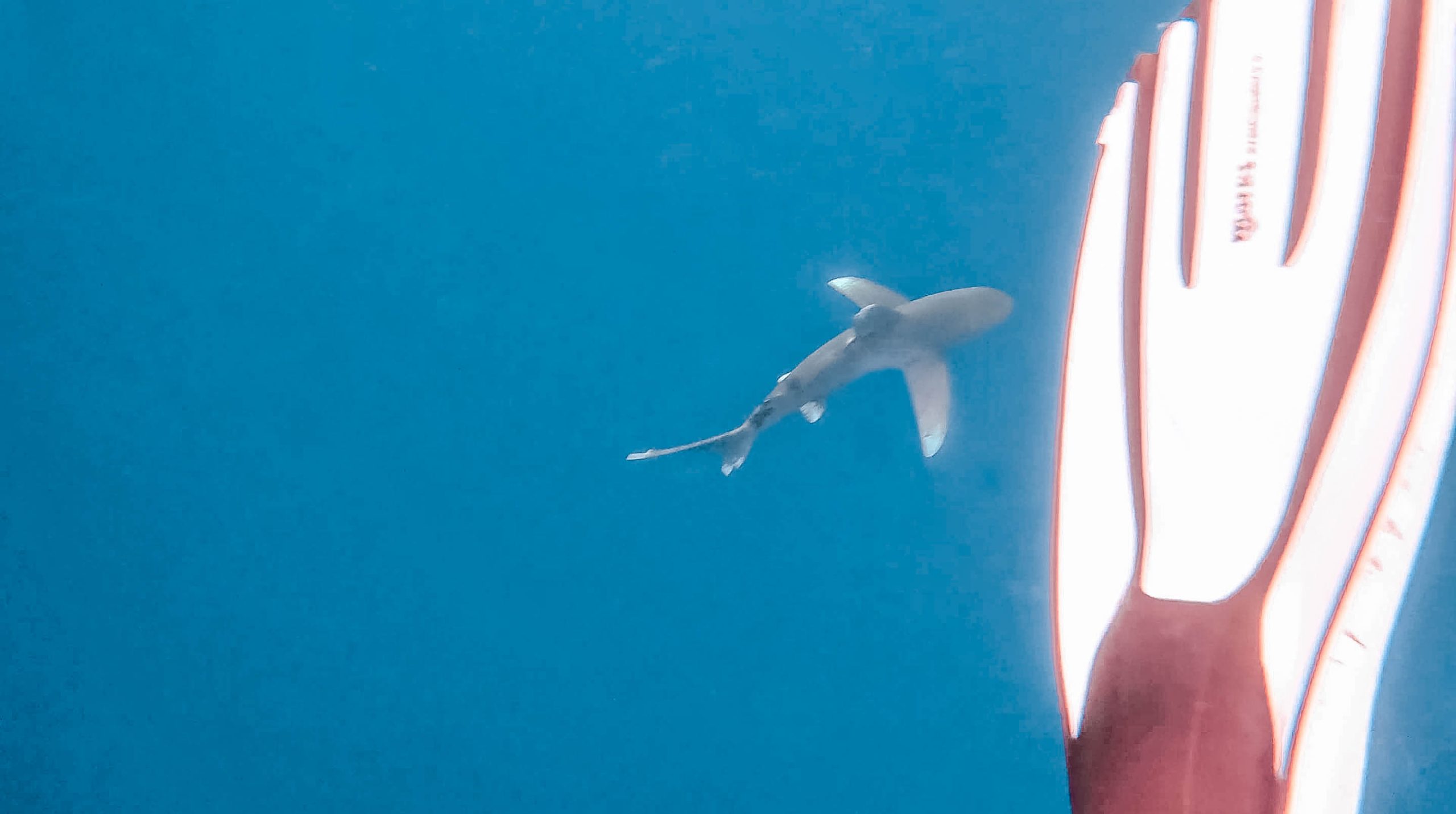
Do's and Dont's When Diving with Oceanic Whitetips
Diving with Oceanic Whitetips is a unique and cool adventure, but it comes with its own set of considerations. These guidelines are provided with the understanding that shark behavior can vary widely, and your reactions to unexpected situations are inherently unpredictable. Diving with these individuals requires respect, caution, and adherence to established protocols.
If you find yourself in the fortunate position to encounter Oceanic Whitetips, particularly in the shallow depths around moored liveaboards or during safety stops, these guidelines offer valuable insights. It's crucial to remain vigilant, as these sharks have a penchant for approaching from unexpected angles, often catching divers off guard. Always check your surroundings, especially behind you.
Remember, these guidelines are just that – guidelines. The Oceanic Whitetip is a graceful yet endangered species, and encountering them is a privilege. Enjoy the experience, but be conscious of the responsibility that comes with sharing their habitat. The future frequency of such encounters remains uncertain, making each interaction a genuine privilege.
Mooring System Ascend:
- Use the boat mooring system for ascend.
- Zodiacs are efficient for descending in water below 5 meters.
- Avoid using zodiacs for ascending in open water due to potential delays.
Pre-Dive Briefing Guidelines:
- Listen attentively to pre-dive briefings.
- Videos showcase what not to do when a shark approaches.
- Follow clear guidelines provided by your local guide.
Respectful Interaction:
- Oceanic Whitetips are curious and wild predators - respect them.
- Keep a watchful eye on the shark, be alert but avoid nervous movements.
Day Dives Only:
- Dive during the day; night dives are restricted in certain areas.
- Limit observation time in the water.
Air Supply Considerations:
- Ascend to safety stop when you have 70 bar left.
- Maintain enough air in case a shark is present during ascend or safety stop.
Group Dynamics:
- Stay in groups and remain deeper than 5 meters, except during ascend.
- 0-5 meters is the territory of the longimanus.
Safe Entry/Exit:
- Keep a safe distance from the water for oceanic presence.
- Enter/exit water quickly and safely, with a negative entry.
- Minimize time at the surface and surface in buddy pairs.
Diving Practices:
- Follow standard diving practices.
- Wear a wetsuit, maintain neutral buoyancy, and stay vertical if the shark is close.
- Avoid sudden movements, splashing with fins, and never turn/swim away from a shark.
Prohibitions:
- No swimming or snorkeling allowed at any time on Brothers or Daedalus.
- Stay close to the reef to minimize chances of close encounters with oceanics.
Managing Expectations:
- Acknowledge the inherent risks of diving with sharks.
- The risk of diving with sharks, including oceanic whitetips, is minimal but not risk-free.
- Our behavior should avoid creating dangerous situations for both humans and sharks.
Adding a Camera Lens of Safety Between You and the Shark
In the realm of diving with sharks, having a camera becomes more than a tool for capturing moments—it acts as a protective barrier. A camera creates a visual "cage" between you and the shark, offering a sense of security, especially with larger and potentially more aggressive species like Bull and Tiger Sharks. This additional layer of safety enhances the overall experience, allowing divers to appreciate the beauty of Oceanic Whitetips with confidence.
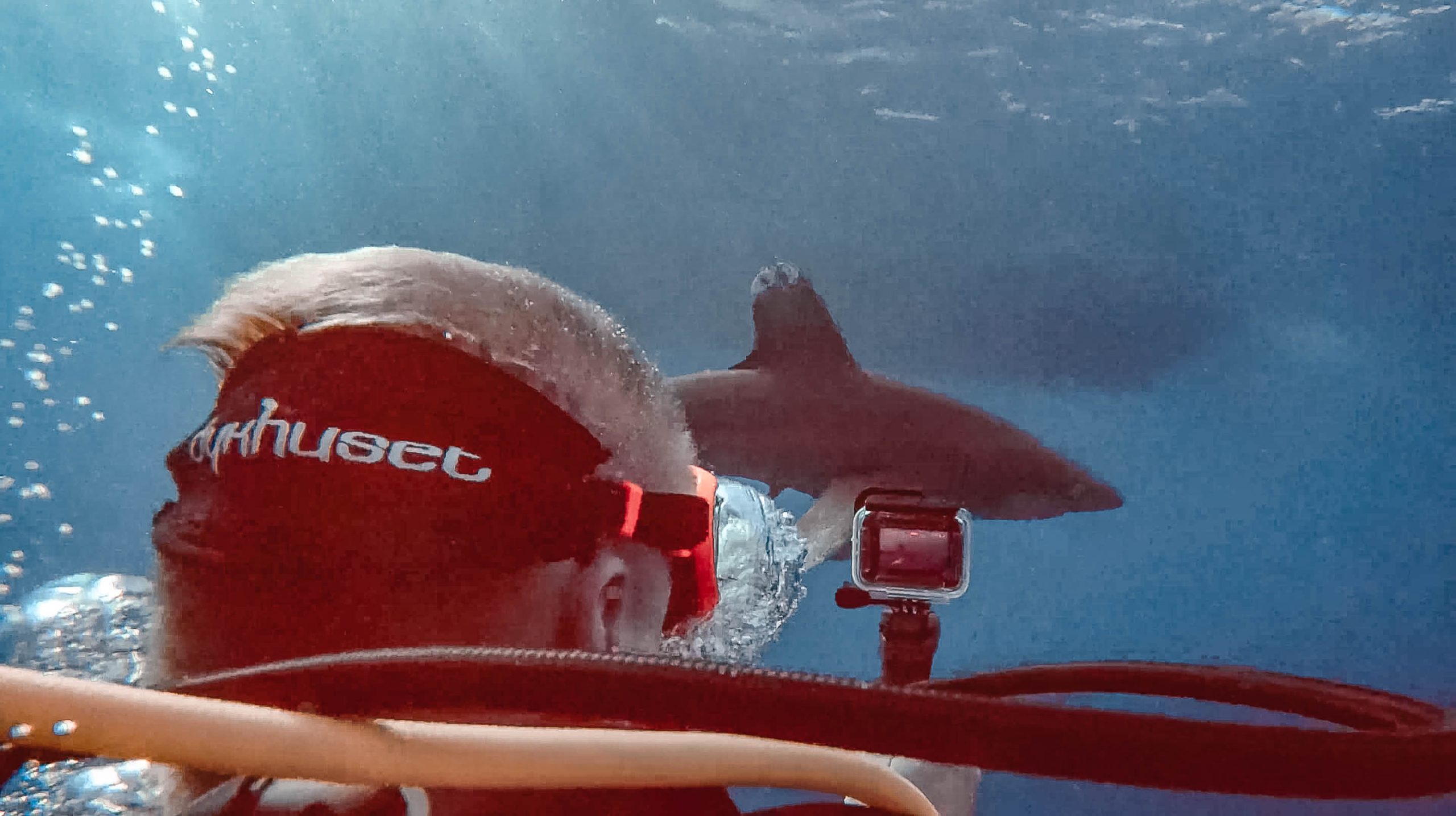
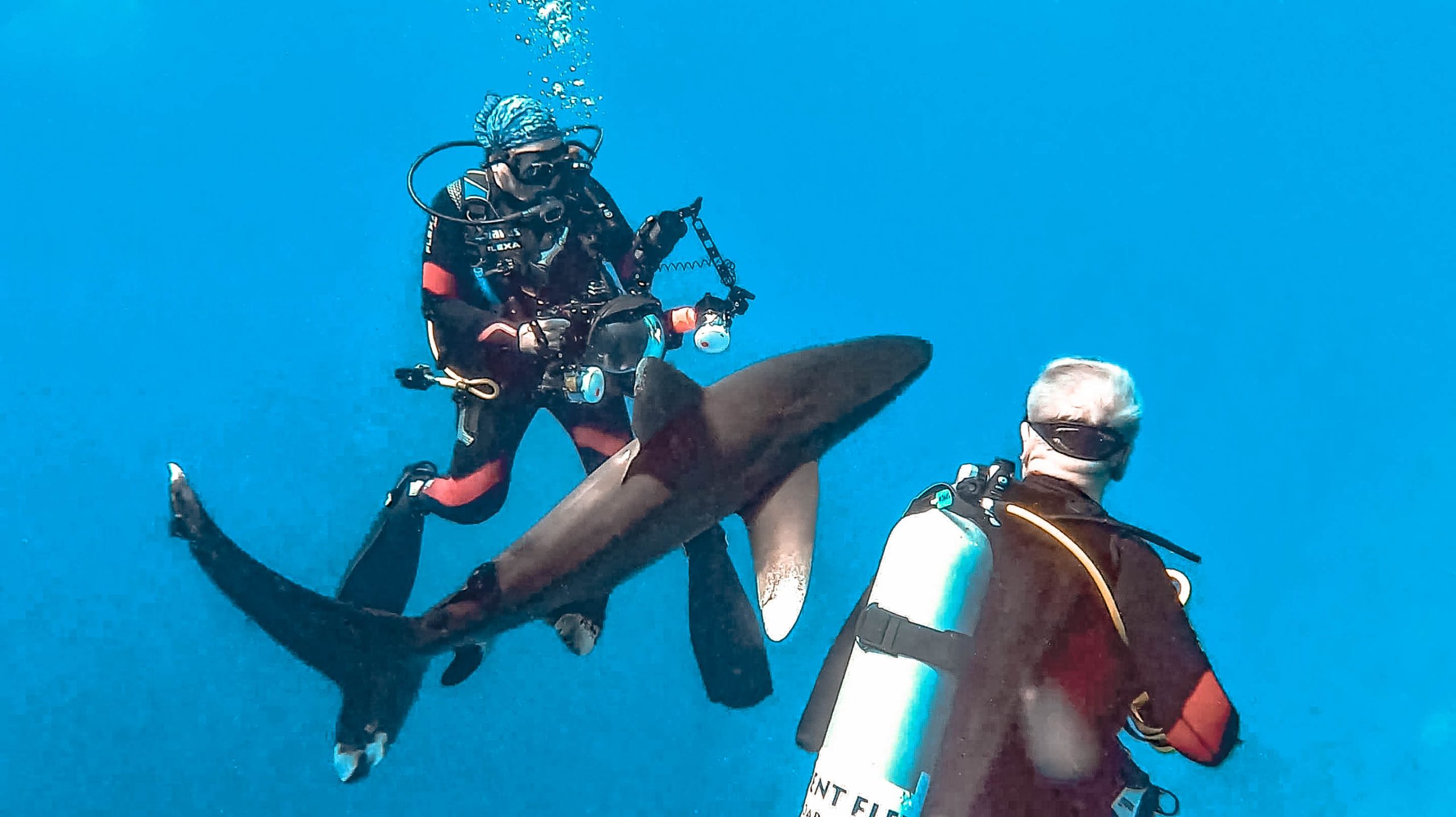
With that said explore the Red Sea's depths, but with responsibility. Dive safely, respect Oceanic Whitetips, and contribute to their preservation. An encounter worth protecting.
Let me know in the comments below if you have any other questions about diving with Oceanic whitetip sharks in the Red Sea!
LIKE THIS POST? PIN IT FOR LATER AND SHARE IT WITH OTHERS!

